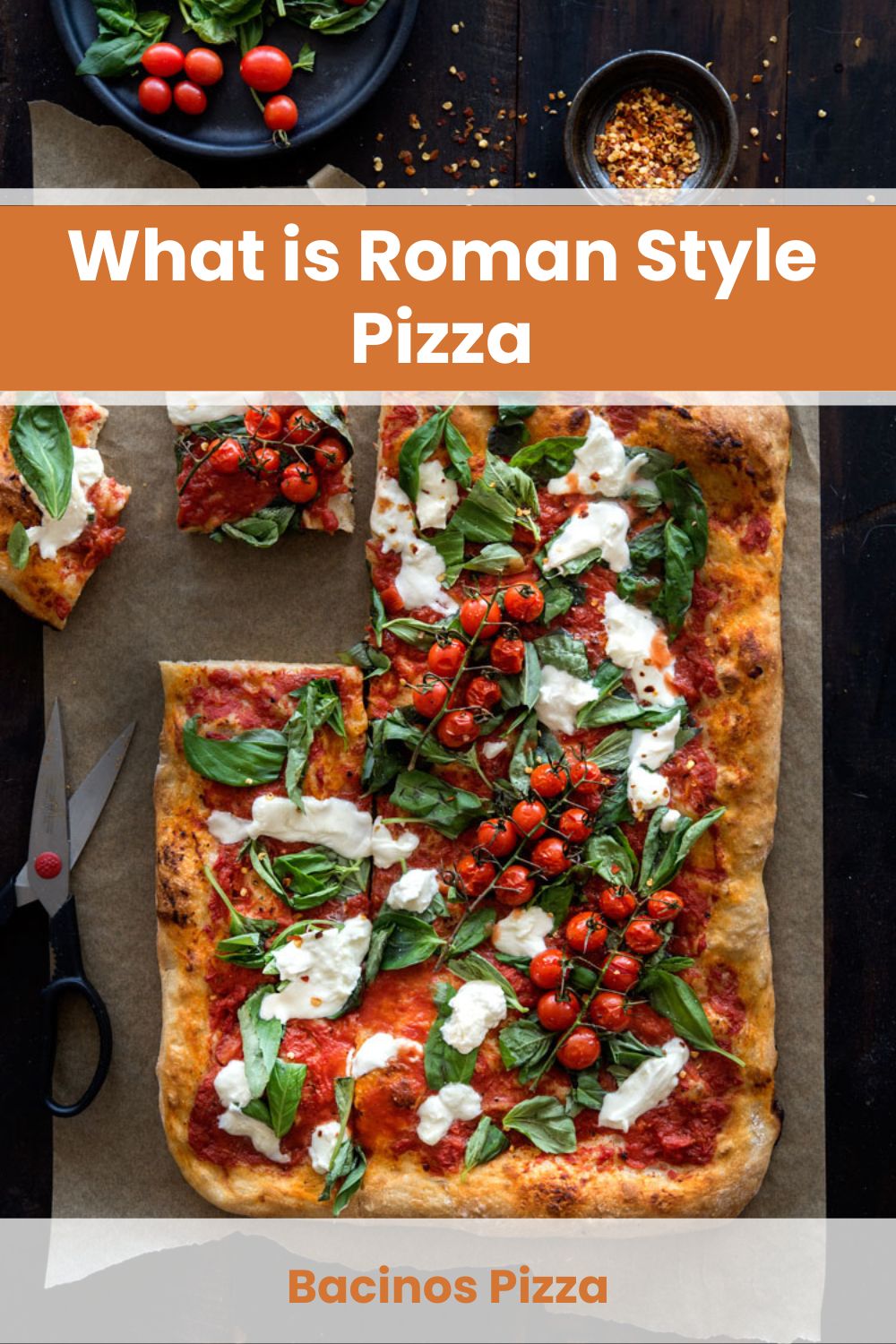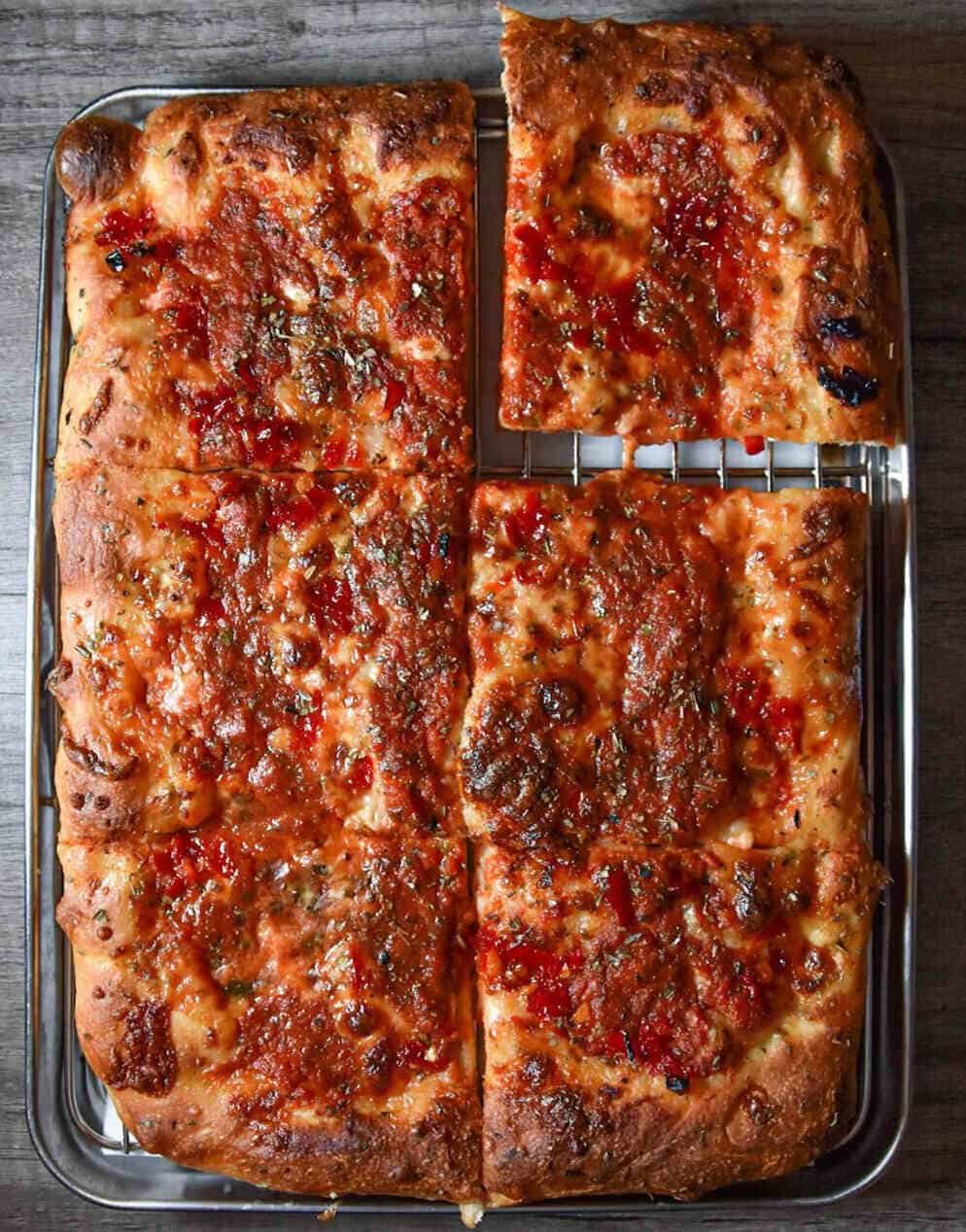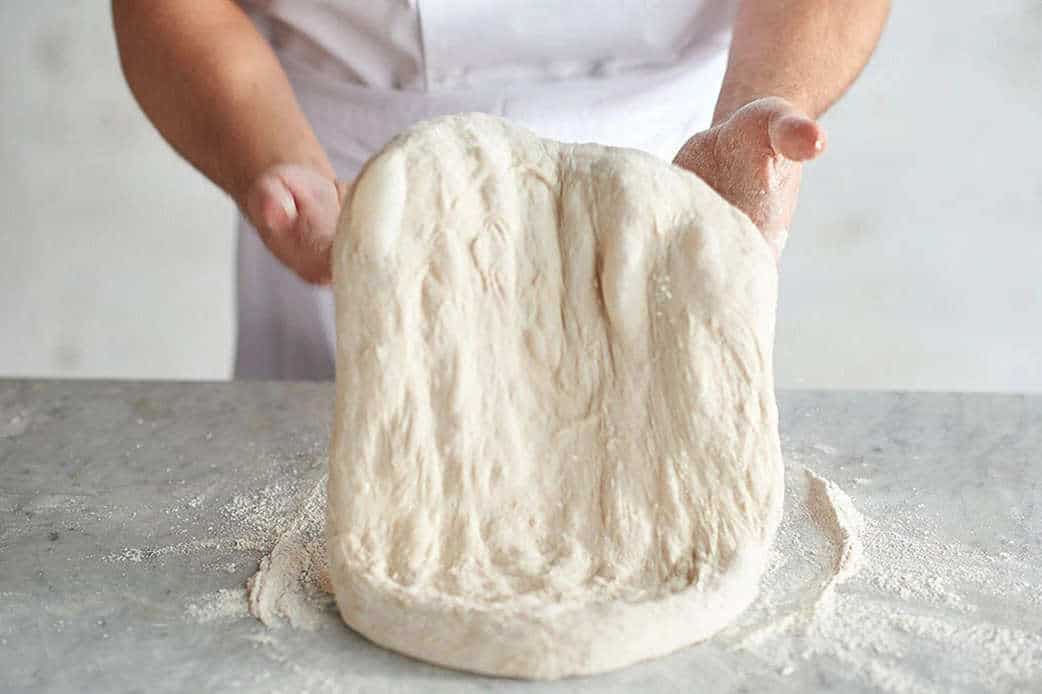To say that pizza is a famous dish is like saying that buildings are tall, the skies are blue, and the oceans are blue. The truth is expert studies support this rather obvious statement by concluding that in the United States alone, there are over three hundred fifty slices of pizza being sold per second.

But did you know another kind of pizza is slowly making its breakthrough globally? It has a massive following in Italy and resembles the famous, flavorful focaccia bread. So, enough of the introduction, let’s dig deeper and talk about Roman-style pizza and what makes it stand out from the rest!
What is a Roman-Style Pizza? A Brief History

| Quick Guide Information | |
| City of Origin | Rome |
| Crust | Slightly Thicker; |
| Toppings | Anything; |
| Type of Oven Used | Deck or hearth oven |
| Type of Pan Used | Carbon & Stainless steel; |
| Cooking Time | 3 -25 minutes; |
| Mixing Method | Machine-mixed; |
| Serving Method | Slice or whole pie; |
| Dough | High-hydration & multi-grain; |
Before jumping to the main points, let us begin by taking a sneak peek at the history of Roman-style pizza, famously known as “pizza al taglio”. This pizza started during the early 18th century in Rome, Italy that was initially served to workers as their lunch since it offered convenient and quick snack bites for them, with cheap prices that could fill their stomachs.
During this era, this pizza was prepared in large trays and cut into squares and rectangles once baked for them to easily pull without any restrictions. This type of pizza is rarely found around Rome but as time pass by, Roman-style pizza gained popularity outside of Rome as time passed, and eventually, it spread to other cities in Italy and beyond.
What Makes a Roman-Style Pizza Stands Out from the Rest?

There are many available pizzas across Italy, whether they be Margherita, Pizza alla Bufala, Calzone, and Neapolitan, to mention a few. While these are all shaped and topped differently, all the pizzas have something in common: they all taste fantastic.
But of course, you might wonder what makes a Roman-style pizza different. How does it stand out from the other pizzas one can buy in Italy? So, to set the record, here are the unique characteristics that make Roman-style pizza extraordinary!
Roman-Style Pizza Crust & Texture
Roman-Style pizzas are best known for their slight hollows on the rectangular surface and their thin to medium crust made of yeast, flour, salt, and water. Compared to other doughs, roman-style pizzas add olive oil to stretch the dough better.
On top of everything, the texture of the Roman-Style pizza is soft and slightly moist on the top while it’s crunchy and light at the bottom. This final texture can be connected to the fact that Roman-Style pizza is made with its dough possessing much-elevated hydration. Proofing is not done with the same tray it baked in, allowing the dough to rise appropriately for a crispier and airy crust.
Frankly, its dough shows little significant differences compared to traditional pizzas; however, its process of making one gave identity to the style. One may mistake Roman-style pizza from traditional one, and below is a quick guide to differ one another!
| Crust | Roman Style | Traditional Pizza |
| Shape | Rectangular | Circular |
| Texture | Crispy | Soft & Chewy |
| Ingredient | Olive oil, flour, yeast, water, & salt. | Flour, yeast, water, & salt |
| Proofing | Separate tray | Same tray |
Toppings & Sauce Used

Like other pizzas, the base of Roman-style pies is topped and enveloped with a tomato sauce made of vine-ripened tomatoes. It, however, does not require a long list of ingredients as simplicity is attained with this version of pizza.
While the toppings can be added based on your desire, a Roman-style pizza is usually accompanied by meats such as sausage, pepperoni, and a generous amount of cheese. Other famous ingredients or toppings of a Roman-style pizza include pecorino cheese, basil, anchovies, tomato sauce, pepper, and mozzarella cheese.
This pizza style holds a value of less is more in terms of toppings since too much of it will keep the crust down, making it heavy and soggy. Make sure to leave some spaces between pizzas to preserve the pizza’s signature airy and crispy crust. As simple as it can be, better to grab fresh ingredients as much as possible to elevate the taste.
Type of Pan Used
The Roman-style pizza uses a carbon-steel or stainless-steel pan beside a hearth deck in the oven. The pan is then oiled with a generous amount of extra virgin olive oil before the chef adds the dough, which helps in giving the Roman-style pizza its much coveted desired crispy bottom. On top of everything, to create and achieve the perfect Roman-style pizza, it’s always best to use a rectangular-shaped pan.
Baking Process & Serving Method

Also, Roman-style pizzas are unique and known because of their different baking process or type of ovens used. Unlike other pizzas, such as Neapolitan-style Pizza cooked in a burning oven, Roman-style pies mostly use a gas deck oven, a baker’s hearth, or even an electric one at almost half the temperature and heat of a wood-fired pizza.
Furthermore, pizzerias served Roman-style pie in a large, rectangular shape with different toppings and sometimes, bakeries from Italy serve it too as they cut the pizza itself with scissors to sell per slice.
Dough
The most noticeable or striking characteristic of the Roman-style pizza is the crumbliness of its dough. It is full of bubbles and light and can be topped with different ingredients.
In addition, the dough contains smaller air pockets which was obtained by adding extra virgin olive oil to make it elastic and decadent. The uniqueness of this dough is further achieved by selecting fresh and authentic ingredients that are baked and prepared accordingly to attain perfection.
Although Roman-style dough is unique as it is, it still has classification depending on their hydration which is explained below:
- Pizza al Taglio Dough: 75% hydration or more, more olive oil, and cool fermentation;
- Pinsa Romana Dough: 70% hydration using different combinations of flours such as whole wheat, spelt, soy, rice, oats, millet, and farro fermented 24 hours or longer.
- Pizza Tonda Dough: 50 to 55% hydration incorporated with olive oil and a short fermentation time of around 6 hours.
Taste
Once you try Roman-style pizza, you’ll understand how unique it tastes, with a distinct tomato and cheese flavor. The olive oil added to the dough also helps to highlight the heartier flavor. Although it has less toppings than other pizzas, it did not make any significant difference as it still tasted lovely partnered with its crispy crust.
Ingredients
- 295 grams of water
- 3 grams of instant yeast
- 10 grams of sugar
- 12 grams of olive oil
- 475 grams of AP flour (11.7% protein)
- 10 grams of salt for the dough
- Pecorino Toscano
- Fresh mozzarella
- Parmigiano Reggiano
- Squeeze Olive Oil
- Flaky Salt
Directions

Step 1
Using a large bowl in your kitchen, stir together sugar and yeast together with warm water and let it stand for about five minutes until its texture becomes foamy.
Step 2
Afterward, add another ¾ cup of flour and around three tablespoons of olive oil into the yeast mixture, stir it slowly, and let it stand for about twenty minutes until you see tiny bubbles forming on the surface.
Step 3
Using a brush, spread one tablespoon of olive oil into a large bowl, then add around ¾ teaspoon of salt and one cup and two tablespoons of flour into the dough. Then, on a lightly floured and flat work surface, start kneading the dough until it forms together in a uniform ball shape. Once done, transfer it to a bowl enveloped in plastic wrap, and once again, let it stand for about one hour and fifteen minutes or until the dough has doubled in size.
Step 4
While waiting, heat one tablespoon of olive oil in a medium saucepan, add some garlic, and cook it over moderate heat. Stir the garlic for thirty seconds until the garlic becomes lightly golden. Then, add some crushed tomatoes to the pan and let it simmer. Once done, remove the garlic and crushed tomatoes from the pan, set it aside, season it with pepper and salt, and allow it to cool down.
Step 5
Then, using a brush, spread around one tablespoon of olive oil into a rimmed baking sheet of a 13-by-18-inch size and slowly press the dough into the pan. With your fingers, dimple the dough and drizzle all over the remaining one tablespoon of olive oil. Finally, let the dough rise for thirty minutes until it’s puffed.
Step 6
Preheat your oven to around 450 degrees Fahrenheit. Spread around six tablespoons of sauce over the pizza dough, leave around a ½ inch border, and reserve the remaining sauce for other use. Cut down the stracciatella into pieces and scatter it all over the pizza. Then, place the pizza dough inside the oven and bake for twenty-five minutes until the cheese and crust are golden browns. Once done, scatter torn basil leaves for some garnish and serve!
Tips and Tricks

- Use fresh dough. It should come as rule of thumb that the foundation of any pizza recipe is fresh pizza dough.
- Try sourcing quality ingredients. Making pizza does not require a long list of ingredients. Better ensure all toppings and cheese are the freshest and best you can find.
- Feel free to turn on the heat.Increase the heat to produce the necessary crisp crust for the best Roman-style pizza.
- Less is more regarding the pizza’s toppings.Adding more toppings may make you feel overwhelmed, but doing so will make the pizza crust heavy and soggy.
Final Thoughts on the Roman-Style Pizza
Roman-style pizzas are extraordinary and unique; they differ in consistency, shape, taste, and natural ingredients in toppings and sauce. But all in all, while these pies may look different from the usual, their flavor is proven and guaranteed delicious!
And now that we know its distinct identity and characteristics, we can enjoy having Roman-style pizza or bake your own, too!
Whether you had a bite or baked a Roman-style pizza, tell us what characteristics you loved the most! Let us know in the comments.

Barbara is an enthusiastic food-exploring person that goes through different culinary experiences. She got inspired by creating a pizza blog post after she tasted one of the best-selling pizzas in Toledo.